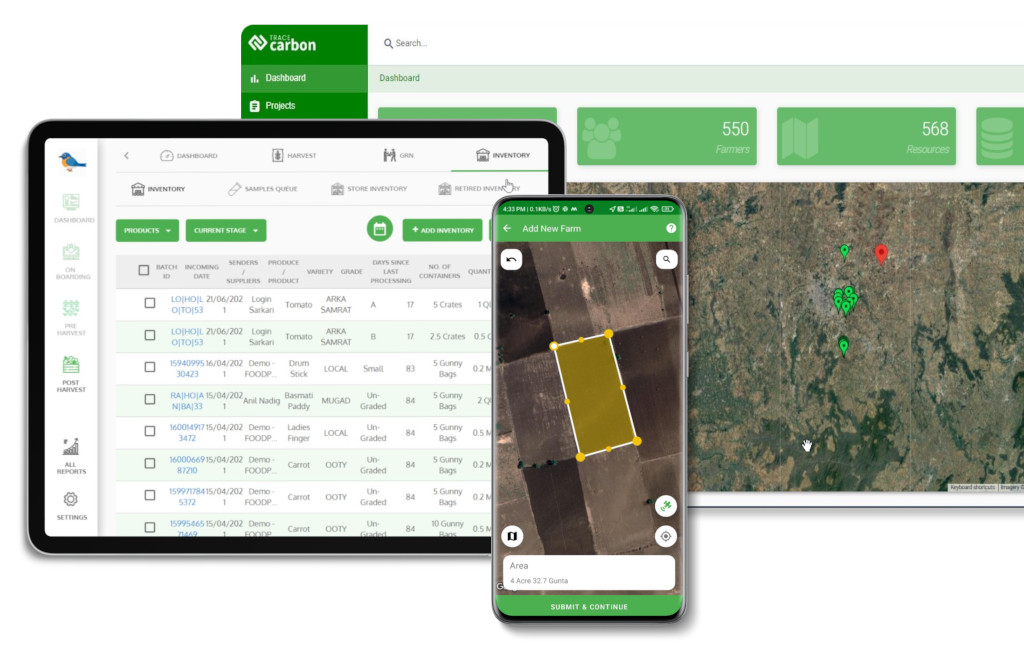Contact: +91 99725 24322 |
Menu
Menu
Quick summary: Learn how businesses can navigate EUDR reporting, ensuring supply chain transparency and compliance with deforestation regulations to secure market access in the EU.

Automation simplifies EUDR reporting by replacing manual spreadsheets with centralized compliance platforms. These tools streamline Due Diligence Statement (DDS) filings, automate geolocation data uploads, and manage supplier declarations in one system. Integrated satellite monitoring and risk scoring ensure deforestation-free sourcing, while audit-ready records reduce penalties and compliance delays. For manufacturers and importers, automated EUDR reporting improves accuracy, scalability, and transparency across complex supply chains, making compliance faster, more reliable, and less resource-intensive.
Companies across Europe are under growing pressure to demonstrate EUDR compliance, with strict requirements for proving deforestation-free sourcing of commodities like wood, leather, coffee, and soy. Yet many businesses still rely on spreadsheets for reporting — a process that is time-consuming, error-prone, and risky when managing hundreds of suppliers and complex product lines. Manual reporting not only slows down operations but also increases the likelihood of mistakes that can lead to costly penalties and reputational damage.
The solution lies in automated reporting tools designed for supply chain traceability. These platforms streamline Due Diligence Statement (DDS) filings, integrate geolocation data uploads, and manage supplier declarations in a single, centralized system. By automating EUDR reporting, companies gain accuracy, scalability, and transparency, while reducing administrative burden and ensuring compliance with evolving EU regulations.
Key Takeaways
The EU Deforestation Regulation (EUDR) raises the bar for businesses by demanding more than just sustainability commitments — it requires evidence-based compliance. To sell or import products such as wood, leather, soy, coffee, rubber, cocoa, or palm oil, companies must:
While these requirements aim to protect forests, they introduce real operational pain points for businesses.
Most companies work with dozens or even hundreds of suppliers. Each uses different systems (or no systems at all), making it difficult to standardize information. For a furniture maker sourcing wood across Europe and leather from global markets, the complexity quickly multiplies.
Compliance doesn’t fail because companies lack intent — it fails because supplier data is inconsistent, incomplete, and scattered.
Geolocation is at the heart of supply chain traceability under EUDR. Every farm, forest, or plot must be mapped — yet many suppliers don’t have the tools to provide accurate polygon data. Mistakes in coordinates or file formats (like faulty GeoJSONs) can result in outright rejection.
The shift to geolocation-based compliance marks a fundamental change: businesses now need to prove where a commodity originated, not just who sold it.
The DDS process is more than box-ticking — it’s a legally binding declaration. Errors, missing details, or late filings put companies at risk of penalties, reputational harm, or blocked shipments. For procurement teams used to managing compliance in Excel, the risk exposure is significant.
DDS filings turn compliance into a legal liability — getting them wrong isn’t just inefficient, it’s dangerous.
EUDR compliance is ongoing, not one-time. Companies must continuously update records as suppliers, sourcing regions, or risk classifications change. With multiple product lines and markets, staying on top of every deadline is a resource-heavy challenge.
Compliance fatigue is real — the pace of reporting can overwhelm teams already stretched thin by supply chain disruptions and rising costs.
EUDR isn’t just another sustainability framework — it fundamentally changes how supply chains are managed. Businesses that continue relying on manual spreadsheets and fragmented supplier communication will face rising costs, delays, and potential non-compliance penalties. Those who embrace automation and centralized traceability systems can transform compliance from a burden into a competitive edge.
Want to go deeper? Read our in-depth guide to EUDR compliance and learn exactly how operators and traders can prepare today.
Not sure how to meet the due diligence requirements? Explore our step-by-step EUDR Due Diligence Guide for practical workflows and real examples.
For many businesses, spreadsheets remain the default tool for compliance tracking. They’re familiar, cheap, and flexible — but when it comes to EUDR compliance, they quickly show their limits. What once worked for small supplier networks is no longer sustainable in an era of supply chain traceability and legally binding reporting.
Manually entering and updating data for hundreds of suppliers creates bottlenecks. Every new declaration, certificate, or geolocation file has to be uploaded and cross-checked by hand. What should be a routine task turns into a time-consuming administrative burden that slows down procurement and compliance teams.
Teams are forced to choose between spending days chasing supplier documents or risking late filings that could block shipments.
Spreadsheets are notoriously error-prone. A mistyped coordinate, a missing supplier declaration, or an overlooked DDS deadline can expose companies to non-compliance penalties under EUDR. Unlike internal mistakes, these errors carry legal and financial consequences, including fines or restricted market access.
Human error doesn’t just waste time — under EUDR, it can directly impact revenue and brand reputation.
EUDR is only the beginning. Future EU regulations will likely demand even greater detail, covering more commodities and requiring digital traceability at scale. Spreadsheets lack the capacity to handle expanding compliance requirements across diverse supplier networks and multiple product lines.
What feels manageable today will collapse tomorrow as reporting scope broadens — leaving companies scrambling to catch up.
When EU authorities request proof, companies need to provide structured, verifiable data. Spreadsheets don’t offer built-in audit trails, making it hard to demonstrate accuracy or trace decisions. Searching for the “right version” of a file during an inspection can delay responses and raise red flags.
Businesses risk appearing disorganized or unreliable in front of regulators and clients, even if their sourcing is compliant.
Relying on spreadsheets for EUDR reporting creates inefficiency, risk, and lost opportunities. As supply chain compliance shifts from paper-based declarations to digital evidence, manual tools simply can’t keep pace with the level of scrutiny and scalability the regulation demands.

For most businesses, the real struggle with EUDR compliance isn’t intent — it’s capacity. Compliance managers and procurement teams are already stretched thin, juggling supplier onboarding, production deadlines, and client demands. Now add the need to collect geolocation files, validate Due Diligence Statements (DDS), and keep every record audit-ready — and suddenly what looks like a regulatory requirement becomes a full-time job for multiple people.
This is where automation doesn’t just “help” — it changes the game.
Problem: Data arrives in fragments — certificates in PDFs, coordinates in emails, declarations in spreadsheets. Teams spend hours chasing documents across inboxes.
Automation’s impact: A single digital hub organizes every supplier record, automatically updating and flagging gaps. Procurement teams regain control instead of firefighting.
Problem: Filing DDS manually means repetitive data entry and the risk of missing a detail that could invalidate a declaration.
Automation’s impact: DDS forms are pre-filled, validated, and submitted on schedule, reducing human error and freeing staff to focus on higher-value compliance checks.
Problem: Even if suppliers send coordinates, verifying them against deforestation maps is tedious and highly technical.
Automation’s impact: Platforms integrate directly with satellite imagery and deforestation alerts, instantly validating whether a farm or forest plot is compliant. No GIS expertise required.
Problem: Most teams only discover compliance gaps when deadlines loom — or worse, when regulators reject a filing.
Automation’s impact: Smart alerts flag risks early, giving businesses time to act before a filing deadline or shipment is blocked. Compliance stops being reactive and becomes proactive.
Problem: Clients and regulators want instant answers, but pulling together spreadsheets across teams can take days.
Automation’s impact: Real-time dashboards show compliance status by supplier, commodity, or region, making audits and client reporting faster, clearer, and less stressful.
Automation turns EUDR reporting from a compliance headache into a manageable, repeatable process. Teams spend less time chasing data and more time building supplier relationships, securing contracts, and strengthening their brand’s reputation for deforestation-free sourcing.

EUDR compliance is no longer just about collecting paperwork — it’s about proving traceability, legality, and deforestation-free sourcing with hard data. TraceX’s Agentic AI EUDR platform achieves this by turning fragmented, manual workflows into a seamless, intelligent compliance system. Here’s how:
The platform connects directly with supplier systems, certification bodies, and external databases. AI agents automatically validate supplier declarations, fill in missing fields, and flag inconsistencies.
The AI auto-generates Due Diligence Statements (DDS) from existing supplier and geolocation data, checks them against EU reporting standards, and submits them to the EU portal on schedule.
Suppliers upload farm or forest polygon data, which the platform validates using integrated satellite imagery and deforestation monitoring APIs. AI agents flag mismatches or non-compliant areas instantly.

Agentic AI continuously monitors supplier data against EU risk benchmarks, certification updates, and country classifications. If something changes — like a supplier’s risk level or a missing document — the system sends automated alerts.
Interactive dashboards give real-time visibility into supply chain traceability by commodity, supplier, or geography. AI generates client-ready reports (including audit trails) in minutes.
EUDR reporting is no longer optional for businesses looking to operate within the EU market. From supply chain transparency to ensuring sustainability, the benefits of compliance extend beyond avoiding penalties. By embracing digital solutions like TraceX and adopting best practices for EUDR reporting, businesses can not only secure their market position but also contribute to global efforts against deforestation. Staying compliant, sustainable, and transparent will be key to thriving in the future of agribusiness.
Looking for the right compliance infrastructure? Explore our guide to EUDR systems and discover how to streamline reporting and traceability.
Confused about Due Diligence Statements? Read our step-by-step blog on DDS filing to ensure smooth, audit-ready compliance.
Want to cut manual effort by 70%? Learn how Agentic AI is transforming EUDR compliance with automation, smart workflows, and real-time monitoring.
AI automates the most complex parts of EUDR compliance — from validating supplier data and generating Due Diligence Statements (DDS) to cross-checking geolocation files against deforestation alerts. Instead of manual data entry and error-prone spreadsheets, AI systems ensure accuracy, speed, and audit-ready records.
Yes. AI-enabled platforms integrate polygon mapping and satellite monitoring to verify whether farm or forest plots are deforestation-free. This ensures that every supplier’s geolocation data is validated in real time, reducing the risk of non-compliance and customs delays.
Beyond compliance, AI reduces administrative workload, cuts costs, and improves supply chain traceability. Businesses gain faster reporting cycles, proactive risk alerts, and stronger trust with regulators and customers demanding deforestation-free sourcing.
